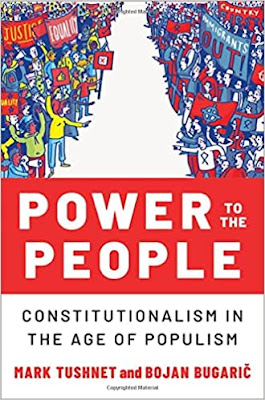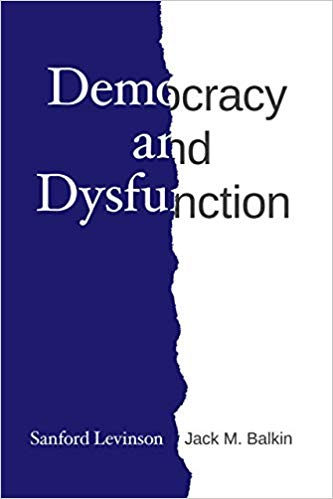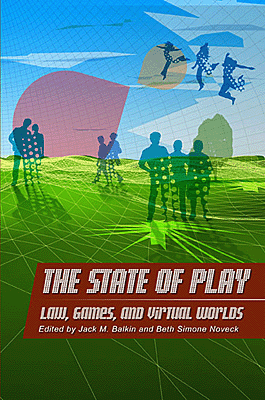Balkinization
an unanticipated consequence of
Jack M. Balkin
Balkinization Symposiums: A Continuing List
E-mail:
Jack Balkin:
jackbalkin at yahoo.com
Bruce Ackerman
bruce.ackerman at yale.edu
Ian Ayres
ian.ayres at yale.edu
Corey Brettschneider
corey_brettschneider at brown.edu
Mary Dudziak
mary.l.dudziak at emory.edu
Joey Fishkin
joey.fishkin at gmail.com
Heather Gerken heather.gerken at yale.edu
Abbe Gluck abbe.gluck at yale.edu
Mark Graber
mgraber at law.umaryland.edu
Stephen Griffin
sgriffin at tulane.edu
Jonathan Hafetz
jonathan.hafetz at shu.edu
Jeremy Kessler
jkessler at law.columbia.edu
Andrew Koppelman
akoppelman at law.northwestern.edu
Marty Lederman
msl46 at law.georgetown.edu
Sanford Levinson
slevinson at law.utexas.edu
David Luban
david.luban at gmail.com
Gerard Magliocca
gmaglioc at iupui.edu
Jason Mazzone
mazzonej at illinois.edu
Linda McClain
lmcclain at bu.edu
John Mikhail
mikhail at law.georgetown.edu
Frank Pasquale
pasquale.frank at gmail.com
Nate Persily
npersily at gmail.com
Michael Stokes Paulsen
michaelstokespaulsen at gmail.com
Deborah Pearlstein
dpearlst at yu.edu
Rick Pildes
rick.pildes at nyu.edu
David Pozen
dpozen at law.columbia.edu
Richard Primus
raprimus at umich.edu
K. Sabeel Rahmansabeel.rahman at brooklaw.edu
Alice Ristroph
alice.ristroph at shu.edu
Neil Siegel
siegel at law.duke.edu
David Super
david.super at law.georgetown.edu
Brian Tamanaha
btamanaha at wulaw.wustl.edu
Nelson Tebbe
nelson.tebbe at brooklaw.edu
Mark Tushnet
mtushnet at law.harvard.edu
Adam Winkler
winkler at ucla.edu
Compendium of posts on Hobby Lobby and related cases
The Anti-Torture Memos: Balkinization Posts on Torture, Interrogation, Detention, War Powers, and OLC
The Anti-Torture Memos (arranged by topic)
Recent Posts
The Corporality of Incarceration
Just A Few Blogs
ACS Blog
Alas, a Blog
Althouse
Arts and Letters Daily
Atrios (Eschaton)
Bill of Health
Buzzflash.com
Buzz Machine
Cato at Liberty
Juan Cole (Informed Comment)
Concurring Opinions
The Constitution in 2020
Corrente
Crooked Timber
Daily Howler
Daily Kos
Dana Boyd
Brad DeLong
Digby (Hullabaloo)
Discriminations
Daniel Drezner
Kevin Drum (Mother Jones)
Electrolite
En Banc
Eunomia (Daniel Larison)
Fafblog
Michael Froomkin (Discourse.net)
GovLab (Beth Noveck)
Rick Hasen (Election Law)
History News Network
How Appealing
Ignatz (Sam Heldman)
The Importance of (Ernie Miller)
Infolaw
Instapundit
International Economic Law and Policy Blog
IntLawGrrls
Jacob Levy
Jesus' General
Jurisdynamics
The Kitchen Cabinet
Mark Kleiman
Law Blog Central
Larry Lessig
Lawyers, Guns and Money
Liberal Oasis
Brian Leiter's Law School Reports
The Leiter Reports
Marginal Revolution
Megan McArdle
Memeorandum
Metafilter
Mirror of Justice
The New Republic
Newseum
No More Mister Nice Blog
Brendan Nyhan
Opinio Juris
Orcinus
The Originalism Blog
Pandagon
Passport (Foreign Policy)
Overcoming Bias
Political Animal (Washington Monthly)
Political Theory Daily Review
Political Wire (Taegan Goddard)
The Poor Man
Virginia Postrel
Prawfsblawg
Public Reason
Jonathan Rauch
Raw Story
Redstate
ReligiousLeftLaw.com
Reporters Committee For Freedom of the Press
Reproductive Rights Blog
Rothman's Roadmap to the Right of Publicity
SCOTUS Blog
Seeing the Forest
Clay Shirky
The Shifted Librarian
The Situationist
Larry Solum (Legal Theory)
Andrew Sullivan
Talking Points Memo
Talk Left
Tapped
Tbogg
TechPresident
The Paper Chase (Jurist)
Tom Paine
Tom Tomorrow (This Modern World)
Eve Tushnet
Uggabugga
University of Chicago Law School Faculty Blog
Unqualified Offerings
The Volokh Conspiracy
War and Piece (Laura Rozen)
Wampum
Oliver Willis
Wonkette
Written Description
Matthew Yglesias
Yin
Your Choice of Feeds
1. XML
powered by
2. Atom Feed
3. RSS 2.0
The Corporality of Incarceration
Guest Blogger
For the Balkinization symposium on Judith Resnik, Impermissible Punishments: How Prison Became a Problem for Democracy (University of Chicago Press, 2025). Ryan Sakoda In Impermissible Punishments: How Prison Became a Problem for Democracy,
Judith Resnik presents a thorough, penetrating, and insightful analysis of the
transatlantic history of punishment over three centuries. The book delves into
individual accounts of those who suffered from the horrible tools of punishment,
provides a detailed transatlantic narrative of the development of and reform to
punishment up to the present day, and explains how incarcerated people
exercised their rights and resisted the most extreme forms of punishment. The introduction of the book
immediately puts the brutality of the carceral system into stark relief,
opening with an image of Winston Talley’s 1965 handwritten petition that
challenged the use of the whip as punishment in the Arkansas prison where he
was incarcerated. A modern audience might be surprised that such punishment
existed as recently as the 1960s and might expect that the court hearing the
case would quickly condemn the brutality of such punishment and grant the
relief Talley sought: “order such floggings stopped. And the Whipp destroyed.” (p.
1) Furthermore, as Resnik points out, “One might assume that ending whipping
would not have been hard the decade
after the UN’s Standard Minimum Rules for the Treatment of Prisoners called for
its abolition.” (p. 171) Talley, however, did not win his case. Chief Judge
Henley, ruling in the case, did not abolish the whip, but instead required that
the Arkansas prisons “establish by appropriate rules and regulations safeguards
surrounding the infliction of corporal punishment on inmates so that the
infliction of such punishment will not constitute cruel and unusual punishment.”
(p. 190) Henley showed a high level of deference to prison officials and
granted them “wide latitude and discretion in the management and operation of
their institutions, including the disciplining of inmates” (p. 183) Resnik
terms this the prison discount, where
“rights are routinely cabined by what corrections officials argue to be
situationally demanded.” (p. 7) Although Talley lost his case,
Resnik emphasizes that his petition was an important step for prisoners’ rights
due to the fact that his challenge was actually heard. As Resnik states,
“[Talley] broke centuries of hegemonic power...[Talley and other] prisoners
established a new proposition—that incarcerated people had the legal authority to call for limits on sovereign
punishment powers.” (p. 6) In 1968, use of the whip was outlawed in Jackson v. Bishop. By modern standards, corporal
punishment of any form seems archaic. And to the modern reader, such forms of
punishment may feel distant from the current discussions around prison reform. Resnik’s
retelling of this history reminds us that these trials were not all that
distant in time (only about 60 years ago), and the book makes these forms of
punishment even more concrete by including photographs of the straps and the
prison farms. Although painful to read and see, bringing these stories and
images to light is one of the major achievements of the book. Prisons are
purposely built out of sight and behind giant walls with little if any
visibility into what goes on inside. This lack of transparency is
perhaps most apparent with respect to the practice of solitary confinement—the
modern prison’s most severe form of confinement—that has generated movements
for reform both inside and outside the prison walls. Today, solitary
confinement remains a commonly used practice across the country. The 2021
Correctional Leaders Association (CLA)-Liman survey estimated that 3.4 percent
of the prison population was being held in solitary confinement for 15 or more
continuous days with 6,000 individuals being held in solitary confinement for
over a year.[1]
The 2023 Solitary Watch and the Unlock the Box Campaign report estimated that
in 2019 there were a total of 122,840 people in solitary confinement in prisons
or jails on any given day (over 6 percent of the incarcerated population).[2] Through legal challenges, hunger
strikes, and other forms of protests, incarcerated people have advocated for
restrictions to the practice of solitary confinement. Resnik’s history shows us
some of the parallels between the circumstances of Talley’s 1965 petition and
these current movements for reform of solitary confinement. As was the case with
respect to whipping, the standards set out in the U.N. Standard Minimum Rules
for the Treatment of Prisoners support these reform efforts. In 2015, the
United Nations made major revisions to their Standard Minimum Rules—which they
renamed the Nelson Mandela Rules—including a new provision stating that any
stay in solitary confinement for over 15 consecutive days is considered cruel,
inhuman, or degrading treatment akin to torture. In addition, legislators in
many states introduced bills restricting the use of solitary confinement and a
few of these bills have been successfully passed into law. The courts, however, which were
(eventually) the source of relief from corporal punishment faced by Talley and
other incarcerated people six decades ago, have been hesitant to establish
meaningful restrictions on the use of solitary confinement. As Resnik explains,
their decisions have constituted “a continual ceding of decision-making to
prison officials.” (p. 557) In the recent decades, the Court, Resnik emphasizes,
“has been pivotal in sustaining both hyperdensity and profound isolation as
‘ordinary incidents’ of prison life.’” (p. 557) Thus, it seems that the courts
have viewed solitary confinement as just another, albeit harsher, form of
incarceration, but categorically different from the corporal punishment
outlawed in the previous century. Resnik rejects this narrow
definition of “corporal punishment.” She states, “[Chief Judge] Henley’s
painful account of Arkansas’ prisons’ density, noise, and violence is why I do
not use the words ‘corporal punishment’ interchangeably with the term
‘whipping.’ Prisons are all-engulfing structures that impose on people’s being
(staff included) from head to toe. It is the corporality of incarceration that is my topic of which Arkansas is
an example, and not an outlier” (p. 8). I view this conceptual point as an incredibly
important one, particularly for current prison reform movements. The courts, however, have generally
viewed the concept of corporal punishment more narrowly, distinguishing and
discounting psychological injury from physical injury. In a 2018 article, Jules
Lobel and Huda Akil point out the discounting of psychological injury in
solitary confinement cases as part of a broader phenomenon in the law, where we
see the discounting of emotional and psychological injury in favor of physical
injury in other areas such as tort law.[3] Current knowledge of solitary
confinement, however, points to the physical
harm of the practice and provides evidence of its corporality even under narrow conceptualizations of corporal
punishment. For example, prolonged periods of solitary confinement have been
known to impact the eyes, with many stories of individuals losing peripheral
vision and depth perception from years spent isolated to a tiny cell. Resnik
cites Albert Woodfox’s memoir describing his practice of doing eye exercises to
prevent the loss of depth perception. (p. 553) Solitary confinement can also
have impacts on the cardiovascular system. Dr. Brie Williams, based on the
records from a 2015 federal lawsuit, reports that the prevalence of
hypertension among a group of 664 incarcerated men ages 27-45 was 31 percentage
points higher among those in solitary confinement than those individuals living
in the general population.[4]
Solitary confinement can also have impacts on the physical brain. As described
in a 2018 article by Jules Lobel and Huda Akil, existing research has established
that social isolation has harmful physical impacts on the brain, and the key
features of solitary confinement produce the conditions associated with these
physical changes to the brain.[5]
The prolonged lack of sunlight can also impact the body. With the minimal time
outdoors, where “[m]any outdoor exercise units have high concrete walls and
partial roofs, ... some prisoners live for years without seeing the sky.” This
prolonged lack of sunlight, Dr. Brie Williams states, can result in vitamin D
deficiency and weaken bones, “putting older adults at risk for fractures and
falls.”[6]
These, along with other physical impacts of solitary confinement,[7]
demonstrate the corporal aspects of
the practice and suggests that restrictions on the use of solitary confinement
warrant the same consideration given to challenges to corporal punishment six
decades ago. Resnik’s book is a meticulous and
sweeping history of punishment and an incredible resource for advocates,
scholars, and the general public. I have learned so much from it, and I know I
will be rereading and revisiting it over the next months and years to take in
its full richness. It is a huge step forward in our understanding of the
origins and development of our criminal legal system and provides us with the context
and language to help us move our system forward to a more humane place. Ryan Sakoda is Assistant Professor of Law at UC Berkeley School of Law. You can reach him by e-mail at rsakoda@berkeley.edu. [1]
Correctional Leaders Ass’n & The
Arthur Liman Ctr. for Pub. Interest Law at Yale Law Sch., Time-In-Cell: A 2021
Snapshot of Restrictive Housing (2022) [2]
Solitary Watch & Unlock the Box
Campaign, Calculating Torture: Analysis of Federal, State, and Local Data
Showing More Than 122,000 People in Solitary Confinement in U.S. Prisons and
Jails (2023). [3]
Jules Lobel & Huda Akil, Law &
Neuroscience: The Case of Solitary Confinement, 147 Daedalus 61 (2018). [4]
Williams, et al., The Cardiovascular
Health Burdens of Solitary Confinement, 34 J.
Gen. Intern. Med. 1977-1978 (2019). [5]
Lobel & Akil, supra note 3. [6]
Williams, Brie A., Older Prisoners and
the Physical Health Effects of Solitary Confinement, 106 Am. J. Public Health 2126-2127 (2016). [7]
See Strong, et al., The Body in Isolation: The Physical Health
Impacts of Incarceration in Solitary Confinement, 15 PLoS One 1 (2020).
Posted
9:30 AM
by Guest Blogger [link]
Books by Balkinization Bloggers

Linda C. McClain and Aziza Ahmed, The Routledge Companion to Gender and COVID-19 (Routledge, 2024)

David Pozen, The Constitution of the War on Drugs (Oxford University Press, 2024)

Jack M. Balkin, Memory and Authority: The Uses of History in Constitutional Interpretation (Yale University Press, 2024)

Mark A. Graber, Punish Treason, Reward Loyalty: The Forgotten Goals of Constitutional Reform after the Civil War (University of Kansas Press, 2023)

Jack M. Balkin, What Roe v. Wade Should Have Said: The Nation's Top Legal Experts Rewrite America's Most Controversial Decision - Revised Edition (NYU Press, 2023)

Andrew Koppelman, Burning Down the House: How Libertarian Philosophy Was Corrupted by Delusion and Greed (St. Martin’s Press, 2022)

Gerard N. Magliocca, Washington's Heir: The Life of Justice Bushrod Washington (Oxford University Press, 2022)

Joseph Fishkin and William E. Forbath, The Anti-Oligarchy Constitution: Reconstructing the Economic Foundations of American Democracy (Harvard University Press, 2022)

Mark Tushnet and Bojan Bugaric, Power to the People: Constitutionalism in the Age of Populism (Oxford University Press 2021).

Mark Philip Bradley and Mary L. Dudziak, eds., Making the Forever War: Marilyn B. Young on the Culture and Politics of American Militarism Culture and Politics in the Cold War and Beyond (University of Massachusetts Press, 2021).

Jack M. Balkin, What Obergefell v. Hodges Should Have Said: The Nation's Top Legal Experts Rewrite America's Same-Sex Marriage Decision (Yale University Press, 2020)

Frank Pasquale, New Laws of Robotics: Defending Human Expertise in the Age of AI (Belknap Press, 2020)

Jack M. Balkin, The Cycles of Constitutional Time (Oxford University Press, 2020)

Mark Tushnet, Taking Back the Constitution: Activist Judges and the Next Age of American Law (Yale University Press 2020).

Andrew Koppelman, Gay Rights vs. Religious Liberty?: The Unnecessary Conflict (Oxford University Press, 2020)

Ezekiel J Emanuel and Abbe R. Gluck, The Trillion Dollar Revolution: How the Affordable Care Act Transformed Politics, Law, and Health Care in America (PublicAffairs, 2020)

Linda C. McClain, Who's the Bigot?: Learning from Conflicts over Marriage and Civil Rights Law (Oxford University Press, 2020)

Sanford Levinson and Jack M. Balkin, Democracy and Dysfunction (University of Chicago Press, 2019)

Sanford Levinson, Written in Stone: Public Monuments in Changing Societies (Duke University Press 2018)

Mark A. Graber, Sanford Levinson, and Mark Tushnet, eds., Constitutional Democracy in Crisis? (Oxford University Press 2018)

Gerard Magliocca, The Heart of the Constitution: How the Bill of Rights became the Bill of Rights (Oxford University Press, 2018)

Cynthia Levinson and Sanford Levinson, Fault Lines in the Constitution: The Framers, Their Fights, and the Flaws that Affect Us Today (Peachtree Publishers, 2017)

Brian Z. Tamanaha, A Realistic Theory of Law (Cambridge University Press 2017)

Sanford Levinson, Nullification and Secession in Modern Constitutional Thought (University Press of Kansas 2016)

Sanford Levinson, An Argument Open to All: Reading The Federalist in the 21st Century (Yale University Press 2015)

Stephen M. Griffin, Broken Trust: Dysfunctional Government and Constitutional Reform (University Press of Kansas, 2015)

Frank Pasquale, The Black Box Society: The Secret Algorithms That Control Money and Information (Harvard University Press, 2015)

Bruce Ackerman, We the People, Volume 3: The Civil Rights Revolution (Harvard University Press, 2014)
Balkinization Symposium on We the People, Volume 3: The Civil Rights Revolution

Joseph Fishkin, Bottlenecks: A New Theory of Equal Opportunity (Oxford University Press, 2014)

Mark A. Graber, A New Introduction to American Constitutionalism (Oxford University Press, 2013)

John Mikhail, Elements of Moral Cognition: Rawls' Linguistic Analogy and the Cognitive Science of Moral and Legal Judgment (Cambridge University Press, 2013)

Gerard N. Magliocca, American Founding Son: John Bingham and the Invention of the Fourteenth Amendment (New York University Press, 2013)

Stephen M. Griffin, Long Wars and the Constitution (Harvard University Press, 2013)

Andrew Koppelman, The Tough Luck Constitution and the Assault on Health Care Reform (Oxford University Press, 2013)

James E. Fleming and Linda C. McClain, Ordered Liberty: Rights, Responsibilities, and Virtues (Harvard University Press, 2013)
Balkinization Symposium on Ordered Liberty: Rights, Responsibilities, and Virtues

Andrew Koppelman, Defending American Religious Neutrality (Harvard University Press, 2013)

Brian Z. Tamanaha, Failing Law Schools (University of Chicago Press, 2012)

Sanford Levinson, Framed: America's 51 Constitutions and the Crisis of Governance (Oxford University Press, 2012)

Linda C. McClain and Joanna L. Grossman, Gender Equality: Dimensions of Women's Equal Citizenship (Cambridge University Press, 2012)

Mary Dudziak, War Time: An Idea, Its History, Its Consequences (Oxford University Press, 2012)

Jack M. Balkin, Living Originalism (Harvard University Press, 2011)

Jason Mazzone, Copyfraud and Other Abuses of Intellectual Property Law (Stanford University Press, 2011)

Richard W. Garnett and Andrew Koppelman, First Amendment Stories, (Foundation Press 2011)

Jack M. Balkin, Constitutional Redemption: Political Faith in an Unjust World (Harvard University Press, 2011)

Gerard Magliocca, The Tragedy of William Jennings Bryan: Constitutional Law and the Politics of Backlash (Yale University Press, 2011)

Bernard Harcourt, The Illusion of Free Markets: Punishment and the Myth of Natural Order (Harvard University Press, 2010)

Bruce Ackerman, The Decline and Fall of the American Republic (Harvard University Press, 2010)
Balkinization Symposium on The Decline and Fall of the American Republic

Ian Ayres. Carrots and Sticks: Unlock the Power of Incentives to Get Things Done (Bantam Books, 2010)

Mark Tushnet, Why the Constitution Matters (Yale University Press 2010)
Ian Ayres and Barry Nalebuff: Lifecycle Investing: A New, Safe, and Audacious Way to Improve the Performance of Your Retirement Portfolio (Basic Books, 2010)
.jpg)
Jack M. Balkin, The Laws of Change: I Ching and the Philosophy of Life (2d Edition, Sybil Creek Press 2009)

Brian Z. Tamanaha, Beyond the Formalist-Realist Divide: The Role of Politics in Judging (Princeton University Press 2009)

Andrew Koppelman and Tobias Barrington Wolff, A Right to Discriminate?: How the Case of Boy Scouts of America v. James Dale Warped the Law of Free Association (Yale University Press 2009)

Jack M. Balkin and Reva B. Siegel, The Constitution in 2020 (Oxford University Press 2009)
Heather K. Gerken, The Democracy Index: Why Our Election System Is Failing and How to Fix It (Princeton University Press 2009)

Mary Dudziak, Exporting American Dreams: Thurgood Marshall's African Journey (Oxford University Press 2008)

David Luban, Legal Ethics and Human Dignity (Cambridge Univ. Press 2007)

Ian Ayres, Super Crunchers: Why Thinking-By-Numbers is the New Way to be Smart (Bantam 2007)

Jack M. Balkin, James Grimmelmann, Eddan Katz, Nimrod Kozlovski, Shlomit Wagman and Tal Zarsky, eds., Cybercrime: Digital Cops in a Networked Environment (N.Y.U. Press 2007)

Jack M. Balkin and Beth Simone Noveck, The State of Play: Law, Games, and Virtual Worlds (N.Y.U. Press 2006)

Andrew Koppelman, Same Sex, Different States: When Same-Sex Marriages Cross State Lines (Yale University Press 2006)
Brian Tamanaha, Law as a Means to an End (Cambridge University Press 2006)
Sanford Levinson, Our Undemocratic Constitution (Oxford University Press 2006)
Mark Graber, Dred Scott and the Problem of Constitutional Evil (Cambridge University Press 2006)
Jack M. Balkin, ed., What Roe v. Wade Should Have Said (N.Y.U. Press 2005)
Sanford Levinson, ed., Torture: A Collection (Oxford University Press 2004)
Balkin.com homepage
Bibliography
Conlaw.net
Cultural Software
Writings
Opeds
The Information Society Project
BrownvBoard.com
Useful Links
Syllabi and Exams